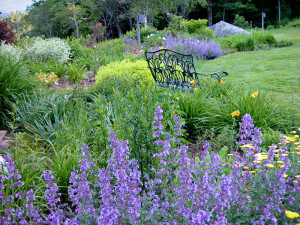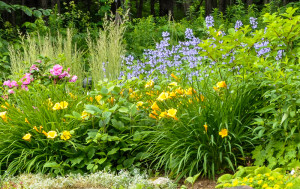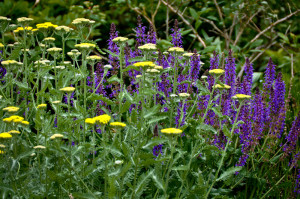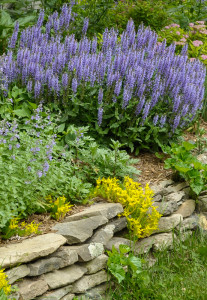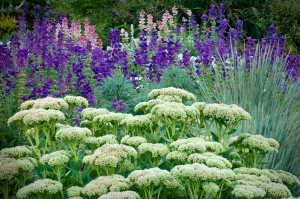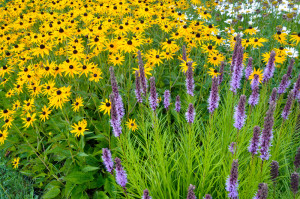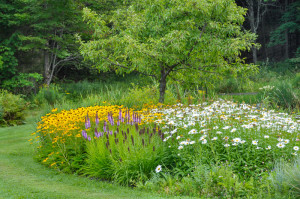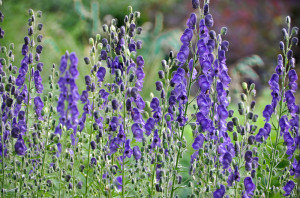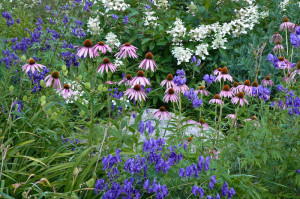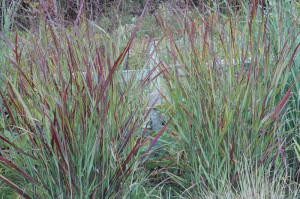Summer spires
Yellow summers
Daisy-like flowers, members of the vast Compositae or Asteraceae family, are the ever-cheerful mainstay of my summer garden.
Seen from afar they create pools of color—predominately yellow or white, plus some pink or orange—that can’t be missed.
And when viewed up close each flower head, which is actually composed of numerous individual florets, reminds me of those happy sun pictures—with the colored rays streaming out from a central disc—that I drew as a child. So here’s to the sunny faces of Echinacea, Shasta Daisies, Rudbeckia and Heliopsis!
And, beyond the daisies, our summer gardens feature plenty of other yellow flowers , especially the prolific Lady’s Mantle, Alchemilla mollis‘, that blooms in June and July, plus all the yellow daylilies that come and go.
The summer garden is indeed yellow.
Seasoning the garden
So, while this all makes for a happy feeling, my garden picture needs some visual spice!!
To perk up my garden palette I look for plants whose forms will make a contrast to the ubiquitous daisies, especially bells or spires, and those with complementary colors, like lavender and purple.
Nepeta, Salvia, Aconitum and Liatris, with their shapely spires of violet, lavender and purple, are easily grown and the perfect answer to this particular design problem. They, along with a collection of tall waving grasses, create the visual seasoning of my summer garden.
Nepeta
Catmint, Nepeta racemosa ‘Walker’s Low’, with its lavender spires, create the perfect foil for the frothy yellow of Alchemilla mollis. When seen en masse it can even be mistaken for real lavender (which is a lovely but reluctant grower in Vermont).
There are also two less well known species of Nepeta: N. subsessellis, the Japanese Catmint, and N. sibirica, the Siberian Catmint, that both stand about three foot high and bloom for eight weeks or longer.
Siberian Catmint is almost identical color to Nepeta racemosa. But, unlike S. racemosa, it is a weaver type of plant with running roots. So grow it among robust companions where the visual intermingling will be appreciated.
Here it is in June behind some Stella d’Oro daylilies, and next to the tall straight feather reed grass, Calamagrostis. Later in the season the background fills out with some bright yellow Heliopsis daisies.
Salvia
The slender spires of Salvia, with individual flowers arranged around a square stem, are readily recognized by most gardeners, but we are probably unaware that Salvia is a large genus of about 900 species, including annuals, perennials and even some shrubs, mostly originating in Europe and central Asia.
The perennial Salvia nemerosa or Meadow Sage is a really useful garden plant. It has slim spikes that range in color from the dark violet of May Night, to the soft blue of ‘Blue Hill’, and all the way to the clean white of ‘Snow Hill’. Right after their initial June blooming, prune off the spent flower stalks, and you should be rewarded with new flowers into August.
The cultivars Salvia nemerosa ‘May Night’ and ‘Snow Hill’ are similar shaped plants but with contrasting colors, and they seem made for each other. Mass them together for a sea of purple and white. Alternatively combine the violet S.’May Night’ with the clear yellow Achillea ‘Moonshine’, as in the picture above.
.
By contrast the cultivar ‘Blue Hill’ forms a gently mounding shape, and I like it up against a totally different type of plant, as with this red peony.
.
.
There is also a relatively new introduction called Salvia ‘Caradonna’, which is a bit taller. Its purplish flowers look stunning against anything yellow, as with this dwarf Spirea “Gold Mound’.
A different species, Salvia verticillata and its cultivar ‘Purple Rain’ has soft purple colored flowers and handsome fuzzy leaves, and it ultimately forms makes a good sized clump that holds it own in the garden.
And finally I am always raving about the annual ‘Clary Sage’ or Salvia horminium, with its attractively colored bracts—pink, purple and white bracts— that look great by themselves or as part of a larger composition, as in this picture with some spiky Blue Oat Grass and Sedum ‘Autumn Joy’.
Clary Sage will self-seed but not excessively. And while it starts out the season slowly, once going it blooms till frost, so is well worth the effort to nurture its seedlings.
Liatris
Liatris spicata is an easily grown Midwestern native known as Kansas Gayfeather. Its purple spires in July and August are the perfect foil for these Black eyed Susans.
And even the spent flower stalks of Liatris contribute their interesting shapes to the winter garden.
.
I started out with the low growing Liatris ‘Kobold’ because I wanted it to show off in front of the masses of daisies. However over the years , presumably as a result of self-seeding, the Liatris in my garden now seem somewhat taller, but not so high that they topple over like some of the taller versions I see elsewhere. And, as this picture shows, even now they still look good with the daisies!
Monkshood
For me Aconitum napellus is the perfect substitute for blue Delphiniums.
Why on earth, you may ask, do I not just grow Delphiniums? The answer is that in our particular location, fairly high on the western slopes of the Green Mountains, I know from bitter experience that whenever the wind shifts markedly and blows out of the south or southeast for about a 24 hour stretch, we are in for fierce and continuous winds that break the stems of vulnerable plants. In the past, even when I staked the delphiniums, they invariably snapped off just above the top tie. It is a quirk of our location, but one I have come to respect when choosing and siting plants.
So back to Monkshood! It is well known that all monkshoods are really poisonous when ingested and even superficial contact can cause skin irritations. (Deer avoid them also!!) So monkshood should only be planted if young children never visit your garden.
Aside from that important caveat, several Monkshood species make magnificent garden plants for full sun or part shade. Leave them alone and over the years they will typically form a very nice display.
The most ‘delphinium-like is Aconitum napellus, growing here in the shade of the Serviceberry trees, and a wonderful contrast to several nearby ‘daisy flowers’.
And the other Monkshood that never fails to attract attention in the garden is Aconitum ‘Spark’s variety‘, where it grows among some Echinacea and backed by the fall Hydrangea ‘Tardiva’.
.
.
.
.
Grasses help us end the season in style
The garden season reaches its climax when the big ornamental grasses fill out and then come into flower.
Sure Blue Oat Grass, Helictotrichon, and the feather reed Grass, Calamagrostis, bloom earlier on. But the giants of the ornamental grasses—Miscanthus, Molinia, Panicum and Schizachyrium wait till late August to bloom.

The plum colored flowers of Miscanthus ‘Malepartus’ are right up there with the tall Rudbeckia ‘Herbstonne’
I have talked about the grasses I grow in my garden elsewhere. Suffice to say, the airy feel of these gentle giants is unique among our garden plants and makes them the perfect complement for many other garden flowers.
And their bloom time, which perfectly coincides with that of the inescapable Rudbeckias, is certainly most fortuitous.
Making pictures
Pleasure gardening is all about making pleasing pictures. And this is a great time of year to take a look at the garden and see where a little change here—or perhaps something more major over there– will make next year’s pictures more attractive. And of course fall is the best time to move things around in preparation for next summer. It’s a bit like adjusting the furniture to make one’s house work better!
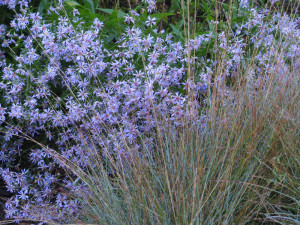
The daisy flowers of Aster oblongifolius contrast perfectly with a clump of ‘Elijah Blue’ Fescue grass
